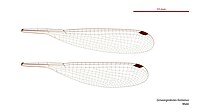Griseargiolestes fontanus
Appearance
| Springs flatwing | |
|---|---|
| Scientific classification | |
| Domain: | Eukaryota |
| Kingdom: | Animalia |
| Phylum: | Arthropoda |
| Class: | Insecta |
| Order: | Odonata |
| Suborder: | Zygoptera |
| Family: | Argiolestidae |
| Genus: | Griseargiolestes |
| Species: | G. fontanus
|
| Binomial name | |
| Griseargiolestes fontanus | |

| |
Griseargiolestes fontanus is a species of Australian damselfly in the family Megapodagrionidae,[3] commonly known as a springs flatwing.[4] It is endemic to south-eastern Queensland and north-eastern New South Wales, where it inhabits streams near their springs.[5]
Griseargiolestes fontanus is a medium-sized damselfly, black-green metallic in colour with pale markings; adults have only a slight pruinescence.[4] Like other members of the family Megapodagrionidae, it rests with its wings outspread.[6]
Griseargiolestes fontanus appears similar to Griseargiolestes albescens, though with less pruinescence.
Gallery
[edit]-
Tip of female tail
-
Tip of male tail
-
Female wings
-
Male wings
See also
[edit]References
[edit]Wikimedia Commons has media related to Griseargiolestes fontanus.
- ^ Dow, R.A. (2017). "Griseargiolestes fontanus". IUCN Red List of Threatened Species. 2017: e.T87532507A87534021. doi:10.2305/IUCN.UK.2017-1.RLTS.T87532507A87534021.en. Retrieved 19 November 2021.
- ^ Tillyard, R.J. (1913). "On some new and rare Australian Agrionidae (Odonata)". Proceedings of the Linnean Society of New South Wales. 37 (1912): 404–479 [419]. doi:10.5962/bhl.part.22352 – via Biodiversity Heritage Library.
- ^ "Species Griseargiolestes fontanus (Tillyard, 1913)". Australian Faunal Directory. Australian Biological Resources Study. 2012. Retrieved 14 April 2017.
- ^ a b Theischinger, Günther; Hawking, John (2006). The Complete Field Guide to Dragonflies of Australia. Collingwood, Victoria, Australia: CSIRO Publishing. p. 50. ISBN 978-0-64309-073-6.
- ^ Theischinger, Gunther; Endersby, Ian (2009). Identification Guide to the Australian Odonata (PDF). Department of Environment, Climate Change and Water NSW. p. 216. ISBN 978-1-74232-475-3.
- ^ Watson, J.A.L.; Theischinger, G.; Abbey, H.M. (1991). The Australian Dragonflies: A Guide to the Identification, Distributions and Habitats of Australian Odonata. Melbourne: CSIRO. ISBN 0643051368.





